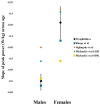Countermovement Jump Peak Power Changes with Age in Masters Weightlifters
- PMID: 39330736
- PMCID: PMC11436148
- DOI: 10.3390/sports12090259
Countermovement Jump Peak Power Changes with Age in Masters Weightlifters
Abstract
Aging is associated with decreased muscle strength and power. Power is particularly important for maintaining the independence of older adults when performing activities of daily living. The countermovement jump has been identified as a reliable and safe method to assess lower extremity power across the lifespan. The purpose of this investigation was to study sex differences and age-related changes in countermovement jump peak power among masters weightlifters with the secondary purpose of comparing results to previous reports of community and masters athletes. Female (n = 63, 39 to 70 yrs, med (56 yrs)) and male (n = 39, 35 to 86 yrs, med (59 yrs)) participants of the 2022 World Masters Championships completed three maximal effort countermovement jump repetitions following a dynamic warm-up. Vertical ground reaction forces were recorded, and peak power normalized to body mass was calculated. Results indicated significant age-related peak power among weightlifters, with the decline being significantly more pronounced in males than females. Female weightlifters exhibited less age-related decline compared to normative data as well as the other Master athlete comparison cohorts (short and long-distance runners), whereas the males demonstrated similar age-related declines as the comparison cohorts. While the female weightlifters in the current study generally demonstrated the least age-related declines in CMJ peak power of the comparative literature, the male weightlifters showed similar age-related decline rates.
Keywords: aging; dynapenia; masters athletes; muscle power; sarcopenia.
Conflict of interest statement
The authors declare no conflicts of interest.
Figures



Similar articles
-
Muscle function in elite master weightlifters.Med Sci Sports Exerc. 2002 Jul;34(7):1199-206. doi: 10.1097/00005768-200207000-00023. Med Sci Sports Exerc. 2002. PMID: 12131263 Clinical Trial.
-
Age-Related Decline in Vertical Jumping Performance in Masters Track and Field Athletes: Concomitant Influence of Body Composition.Front Physiol. 2021 Apr 1;12:643649. doi: 10.3389/fphys.2021.643649. eCollection 2021. Front Physiol. 2021. PMID: 33868010 Free PMC article.
-
Identifying a Test to Monitor Weightlifting Performance in Competitive Male and Female Weightlifters.Sports (Basel). 2018 May 23;6(2):46. doi: 10.3390/sports6020046. Sports (Basel). 2018. PMID: 29910350 Free PMC article.
-
Unique aspects of competitive weightlifting: performance, training and physiology.Sports Med. 2012 Sep 1;42(9):769-90. doi: 10.1007/BF03262294. Sports Med. 2012. PMID: 22873835 Review.
-
Athletic Performance Decline Over the Life Span: Cross-Sectional and Longitudinal Analyses of Elite and Masters Track-and-Field Data.Int J Sports Physiol Perform. 2024 Jul 17;19(9):897-904. doi: 10.1123/ijspp.2023-0431. Print 2024 Sep 1. Int J Sports Physiol Perform. 2024. PMID: 39019444
Cited by
-
Physical and Biomechanical Relationships with Countermovement Jump Performance in Team Sports: Implications for Athletic Development and Injury Risk.Sports (Basel). 2025 Aug 20;13(8):277. doi: 10.3390/sports13080277. Sports (Basel). 2025. PMID: 40863786 Free PMC article. Review.
References
-
- Tanaka H., Tarumi T., Rittweger J. Aging and Physiological Lessons from Master Athletes. Compr. Physiol. 2019;10:261–296. - PubMed
-
- Lauretani F., Russo C.R., Bandinelli S., Bartali B., Cavazzini C., Di Iorio A., Corsi A.M., Rantanen T., Guralnik J.M., Ferrucci L. Age-associated changes in skeletal muscles and their effect on mobility: An operational diagnosis of sarcopenia. J. Appl. Physiol. (1985) 2003;95:1851–1860. doi: 10.1152/japplphysiol.00246.2003. - DOI - PubMed
LinkOut - more resources
Full Text Sources

